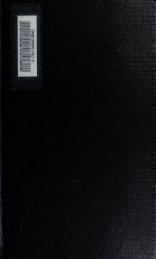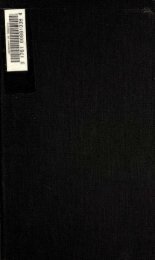Texts from the Buddhist canon : commonly known as Dhammapada
Texts from the Buddhist canon : commonly known as Dhammapada
Texts from the Buddhist canon : commonly known as Dhammapada
Create successful ePaper yourself
Turn your PDF publications into a flip-book with our unique Google optimized e-Paper software.
INTRODUCTION. 13<br />
works contain <strong>the</strong> same succession of subjects, wMlst<br />
<strong>the</strong>re are seventy-nine more stanz<strong>as</strong> in <strong>the</strong> Chinese than<br />
in <strong>the</strong> P41i throughout <strong>the</strong> chapters common to each.<br />
We may re<strong>as</strong>onably ga<strong>the</strong>r <strong>from</strong> <strong>the</strong> entire considera-<br />
tion that <strong>the</strong> version of <strong>Dhammapada</strong> by Dharmatr^ta,<br />
which -w<strong>as</strong> brought to China by Wei-chi-lan, -w<strong>as</strong> itself<br />
a recension of an earlier edition of <strong>the</strong> same •work<br />
kno-wn in India— ^that Dharmatr§,ta, -whilst retaining <strong>the</strong><br />
number of chapters and <strong>the</strong>ir subjects of consideration,<br />
added some additional stanz<strong>as</strong> to <strong>the</strong>m, and that this -work<br />
so revised or re-edited, w<strong>as</strong> accepted by <strong>the</strong> Council held<br />
under <strong>the</strong> presidency of his nephew V<strong>as</strong>umitra, during<br />
<strong>the</strong> reign of Kanishka, and thus acquired <strong>the</strong> reputation<br />
of a <strong>canon</strong>ical portion of <strong>the</strong> Tripitaka.l If, however, <strong>the</strong><br />
additions made to <strong>the</strong> number of stanz<strong>as</strong> in <strong>the</strong> different<br />
chapters can be referred to <strong>the</strong> Chinese editors (<strong>the</strong>mselves<br />
Indians),<strong>the</strong>n we may argue that <strong>the</strong> copies of <strong>Dhammapada</strong>,<br />
<strong>known</strong> in <strong>the</strong> north and south, may both be compilations<br />
of Dharmatrata, and that he w<strong>as</strong> <strong>the</strong> first to draw up this<br />
collection of texts and to give it (<strong>from</strong> his own personal<br />
authority) <strong>the</strong> character of a <strong>canon</strong>ical book.<br />
With respect to <strong>the</strong> accuracy of <strong>the</strong> Chinese version, it<br />
will be plain' to every Chinese scholar <strong>from</strong> <strong>the</strong> following<br />
p<strong>as</strong>sage, that entire reliance may be placed on it. I will<br />
select <strong>the</strong> twenty-fifth chapter of <strong>the</strong> PSli and <strong>the</strong> thirty-<br />
fourth of <strong>the</strong> Chinese for comparison: <strong>the</strong> former contains<br />
twenty-three stanz<strong>as</strong>, <strong>the</strong> latter thirty-two. The<br />
title in <strong>the</strong> one c<strong>as</strong>e is " The Shaman," in <strong>the</strong> o<strong>the</strong>r " The<br />
Bhikshu":<br />
1 There are some references to Yaibh&shik<strong>as</strong>. It would not be sur-<br />
Dharmatr4ta in M. W<strong>as</strong>silief's work prising if we found that <strong>the</strong> edition<br />
on "Buddhism" (le Eouddisme, of <strong>Dhammapada</strong> prepared by Dhar-<br />
Paris, 1865) viz., in §§ 48, 50, 270. matrata, belonged to <strong>the</strong> Vaibh^ahika<br />
From <strong>the</strong>se it would seem that he school, whilst that <strong>known</strong> in Ceylon<br />
w<strong>as</strong> one of <strong>the</strong> great leaders of <strong>the</strong> w<strong>as</strong> compiled by <strong>the</strong> Sautr&ntik<strong>as</strong>.





